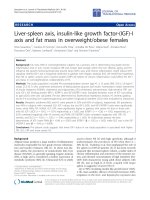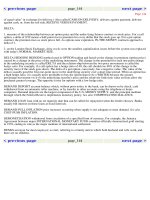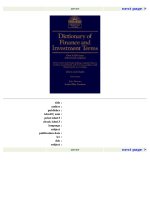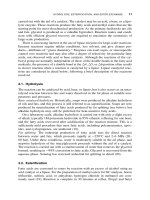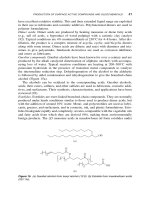bailey s industrial oil and fat products sixth edition phần 1 pot
Bạn đang xem bản rút gọn của tài liệu. Xem và tải ngay bản đầy đủ của tài liệu tại đây (124.9 KB, 10 trang )
1
Chemistry of Fatty Acids
Charlie Scrimgeour
Scottish Crop Research Institute
Dundee, Scotland
1. INTRODUCTION
Fatty acids, esterified to glycerol, are the main constituents of oils and fats. The
industrial exploitation of oils and fats, both for food and oleochemical products, is
based on chemical modification of both the carboxyl and unsaturated groups present
in fatty acids. Although the most reactive sites in fatty acids are the carboxyl group
and double bonds, methylenes adjacent to them are activated, increasing their
reactivity. Only rarely do saturated chains show reactivity. Carboxyl groups and
unsaturated centers usually react independently, but when in close proximity, both
may react through neighboring group participation. In enzymatic reactions, the
reactivity of the carboxyl group can be influenced by the presence of a nearby double
bond.
The industrial chemistry of oils and fats is a mature technology, with decades of
experience and refinement behind current practices. It is not, however, static. Envir-
onmental pressures demand cleaner processes, and there is a market for new pro-
ducts. Current developments are in three areas: ‘‘green’’ chemistry, using cleaner
processes, less energy, and renewable resources; enzyme catalyzed reactions,
used both as environmentally friendly processes and to produce tailor-made
products; and novel chemistry to functionalize the carbon chain, leading to new
Bailey’s Industrial Oil and Fat Products, Sixth Edition, Six Volume Set.
Edited by Fereidoon Shahidi. Copyright # 2005 John Wiley & Sons, Inc.
1
compounds. Changing perceptions of what is nutritionally desirable in fat-based
products also drives changing technology; interesterification is more widely
used and may replace partial hydrogenation in the formulation of some modified
fats.
The coverage in this chapter is necessarily selective, focusing on aspects of fatty
acid and lipid chemistry relevant to the analysis and industrial exploitation of oils
and fats. The emphasis is on fatty acids and acylglycerols found in commodity oils
and the reactions used in the food and oleochemical industries. The practical appli-
cation of this chemistry is dealt with in detail in other chapters. Current areas
of research, either to improve existing processes or to develop new ones, are also
covered, a common theme being the use of chemical and enzyme catalysts. Com-
pounds of second-row transition metals rhodium and ruthenium and the oxides of
rhenium and tungsten have attracted particular interest as catalysts for diverse reac-
tions at double bonds. Recent interest in developing novel compounds by functio-
nalizing the fatty acid chain is also mentioned. To date, few of these developments
have found industrial use, but they suggest where future developments are likely.
A number of recent reviews and books cover and expand on topics discussed
here (1–10).
2. COMPOSITION AND STRUCTURE
2.1. Fatty Acids
Fatty acids are almost entirely straight chain aliphatic carboxylic acids. The broad-
est definition includes all chain lengths, but most natural fatty acids are C
4
to C
22
,
with C
18
most common. Naturally occurring fatty acids share a common biosynth-
esis. The chain is built from two carbon units, and cis double bonds are inserted by
desaturase enzymes at specific positions relative to the carboxyl group. This results
in even-chain-length fatty acids with a characteristic pattern of methylene inter-
rupted cis double bonds. A large number of fatty acids varying in chain length
and unsaturation result from this pathway.
Systematic names for fatty acids are too cumbersome for general use, and
shorter alternatives are widely used. Two numbers separated by a colon give,
respectively, the chain length and number of double bonds: octadecenoic acid
with 18 carbons and 1 double bond is therefore 18:1. The position of double bonds
is indicated in a number of ways: explicitly, defining the position and configuration;
or locating double bonds relative to the methyl or carboxyl ends of the chain.
Double-bond position relative to the methyl end is shown as n-x or ox, where x
is the number of carbons from the methyl end. The n-system is now preferred,
but both are widely used. The position of the first double bond from the carboxyl
end is designated Áx. Common names (Table 1) may be historical, often conveying
no structural information, or abbreviations of systematic names. Alternative repre-
2 CHEMISTRY OF FATTY ACIDS
sentations of linoleic acid (1) are 9Z,12Z-octadecadienoic acid; 18:2 9c12c; 18:2
n-6; 18:2 o6; 18:2 Á9,12; or CH
3
(CH
2
)
4
CH
ÀÀ
ÀÀ
CHCH
2
CH
ÀÀ
ÀÀ
CH(CH
2
)
7
COOH.
COOH
1912
18
1
The terms cis and trans, abbreviated c and t, are used widely for double-bond
geometry; as with only two substituents, there is no ambiguity that requires the sys-
tematic Z/E convention. An expansive discussion of fatty acid and lipid nomencla-
ture and structure appears in Akoh and Min (1).
TABLE 1. (b) Occurrence.
Fatty Acid Significant Sources
4:0 butter, dairy fats
6:0 (coconut, palm kernel)
8:0 (coconut, palm kernel)
10:0 (coconut, palm kernel)
12:0 coconut, palm kernel
14:0 coconut, palm kernel
16:0 cottonseed, palm
18:0 cocoa butter, tallow
18:1 9c cottonseed, olive, palm, rape
18:2 9c12c corn, sesame, soybean, sunflower
18:3 9c12c15c linseed
20:1 13c high erucic rape
20:5 5c8c11c14c17c fish and animal fats
22:6 4c7c10c13c16c19c fish and animal fats
TABLE 1. Fatty Acids in Commodity Oils and Fats. (a) Nomenclature and Structure.
Fatty acid Common name Formula Chain length
4:0 butyric CH
3
(CH
2
)
2
CO
2
H short
6:0 caproic CH
3
(CH
2
)
4
CO
2
H short
8:0 caprylic CH
3
(CH
2
)
6
CO
2
H short/medium
10:0 capric CH
3
(CH
2
)
8
CO
2
H medium
12:0 lauric CH
3
(CH
2
)
10
CO
2
H medium
14:0 myristic CH
3
(CH
2
)
12
CO
2
H medium
16:0 palmitic CH
3
(CH
2
)
14
CO
2
H
18:0 stearic CH
3
(CH
2
)
16
CO
2
H
18:1 9c oleic CH
3
(CH
2
)
7
CH
ÀÀ
ÀÀ
CH(CH
2
)
7
CO
2
H
18:2 9c12c linoleic CH
3
(CH
2
)
4
(CH
ÀÀ
ÀÀ
CHCH
2
)
2
(CH
2
)
6
CO
2
H
18:3 9c12c15c a-linolenic CH
3
CH
2
(CH
ÀÀ
ÀÀ
CHCH
2
)
3
(CH
2
)
6
CO
2
H
22:1 13c erucic CH
3
(CH
2
)
7
CH
ÀÀ
ÀÀ
CH(CH
2
)
11
CO
2
H long
20:5 5c 8c11c14c17c EPA
Ã
CH
3
CH
2
(CH
ÀÀ
ÀÀ
CHCH
2
)
5
(CH
2
)
2
CO
2
H long
22:6 4c7c10c13c16c19c DHA
Ã
CH
3
CH
2
(CH
ÀÀ
ÀÀ
CHCH
2
)
6
CH
2
CO
2
H long
Ã
Abbreviations of the systematic names eicosapentaenoic acid and docosahexaenoic acid.
COMPOSITION AND STRUCTURE
3
Over 1000 fatty acids are known, but 20 or less are encountered in significant
amounts in the oils and fats of commercial importance (Table 1). The most common
acids are C
16
and C
18
. Below this range, they are characterized as short or medium
chain and above it as long-chain acids.
Fatty acids with trans or non-methylene-interrupted unsaturation occur naturally
or are formed during processing; for example, vaccenic acid (18:1 11t) and the con-
jugated linoleic acid (CLA) rumenic acid (18:2 9t11c) are found in dairy fats.
Hydroxy, epoxy, cyclopropane, cyclopropene acetylenic, and methyl branched fatty
acids are known, but only ricinoleic acid (12(R)-hydroxy-9Z-octadecenoic acid) (2)
from castor oil is used for oleochemical production. Oils containing vernolic acid
(12(S),13(R)-epoxy-9Z-octadecenoic acid) (3) have potential for industrial use.
2
COOH
OH
COOH
3
O
HH
Typical fatty acid composition of the most widely traded commodity oils is
shown in Table 2.
TABLE 2. Fatty Acid Content of the Major Commodity Oils (wt%).
16:0 18:1 18:2 18:3 Other
(wt%) (wt%) (wt%) (wt%) [Fatty Acid (wt%)]
butter 28 14 1 1 4:0 (9); 6:0–12:0 (18); 14:0 (14) þ odd chain
and trans
castor 1 3 4 18:1(OH) (90)
coconut 9 6 2 8:0 (8); 10:0 (7); 12:0 (48); 14:0 (18)
corn 13 31 52 1
cottonseed 24 19 53
fish
Ã
14 22 1 16:1 n-7 (12); 20:1 n-9 (12); 22:1 n-11 (11);
20:5 n-3 (7); 22:6 n-3 (7)
groundnut 13 37 41 C
20
–C
24
(7)
(peanut)
lard 27 44 11 1 14:0 (2) 18:0 (11) þ long and odd chain
linseed 6 17 14 60
olive 10 78 7
palm 44 40 10
palm kernel 9 15 2 8:0 (3); 10:0 (4); 12:0 (49); 14:0 (16)
rape
ÃÃ
4 562610
sesame 9 38 45 18:0 (6)
soybean 11 22 53 8
sunflower 6 18 69 18:0 (6)
tallow 26 31 2 14:0 (6) 18:0 (31) þ long and odd chain
Typical midrange values shown; the balance are minor components. Data from (9).
Ã
Cod liver oil.
ÃÃ
Low-erucic-acid rape, e.g., Canola.
4 CHEMISTRY OF FATTY ACIDS
Most commodity oils contain fatty acids with chain lengths between C
16
and
C
22
, with C
18
fatty acids dominating in most plant oils. Palm kernel and coconut,
sources of medium-chain fatty acids, are referred to as lauric oils. Animal fats have
a wider range of chain length, and high erucic varieties of rape are rich in this
C
22
monoene acid. Potential new oil crops with unusual unsaturation or additional
functionality are under development. Compilations of the fatty acid composition of
oils and fats (6, 9, 11, 12) and less-common fatty acids (13) are available.
The basic structure, a hydrophobic hydrocarbon chain with a hydrophilic polar
group at one end, endows fatty acids and their derivatives with distinctive proper-
ties, reflected in both their food and industrial use. Saturated fatty acids have a
straight hydrocarbon chain. A trans-double bond is accommodated with little
change in shape, but a cis bond introduces a pronounced bend in the chain (Fig. 1).
In the solid phase, fatty acids and related compounds pack with the hydrocarbon
chains aligned and, usually, the polar groups together. The details of the packing,
such as the unit cell angles and head-to-tail or head-to-head arrangement depend on
the fatty acid structure (Fig. 2).
The melting point increases with chain length and decreases with increased
unsaturation (Table 3). Among saturated acids, odd chain acids are lower melting
than adjacent even chain acids. The presence of cis-double bonds markedly lowers
the melting point, the bent chains packing less well. Trans-acids have melting
points much closer to those of the corresponding saturates. Polymorphism results
in two or more solid phases with different melting points. Methyl esters are lower
melting than fatty acids but follow similar trends.
Fatty acid salts and many polar derivatives of fatty acids are amphiphilic, pos-
sessing both hydrophobic and hydrophilic areas within the one molecule. These are
surface-active compounds that form monolayers at water/air and water/surface
interfaces and micelles in solution. Their surface-active properties are highly
dependent on the nature of the polar head group and, to a lesser extent, on the
length of the alkyl chain. Most oleochemical processes are modifications of the car-
boxyl group to produce specific surfactants.
TABLE 3. Melting Points of Some Fatty Acids and Methyl Esters
Illustrating the Effect of Chain Length and Unsaturation.
Fatty acid Melting Point (
C) Fatty Acid Melting Point (
C)
16:0 62.9 (30.7)
17:0 61.3 (29.7)
18:0 70.1 (37.8)
18:1 9c 16.3, 13.4 18:1 9t 45
18:2 9c12c À5 18:2 9t12t 29
19:0 69.4 (38.5)
20:0 76.1 (46.4)
Values for methyl esters in parenthesis.
Data from (8) and (9).
COMPOSITION AND STRUCTURE
5
2.2. Acylglycerols
Fatty acids in oils and fats are found esterified to glycerol. Glycerol (1,2,3-trihy-
droxypropane) is a prochiral molecule. It has a plane of symmetry, but if the pri-
mary hydroxyls are esterified to different groups, the resulting molecule is chiral
and exists as two enantiomers. The stereospecific numbering system is used to
Figure 2. Simplified diagram shows packing patterns of fatty acids in the solid phase. (a) and
(b): Hydrocarbon tails (straight lines) aligned at different angles to the line of the polar head
groups (circles). (c): Head to tail packing. (d): Head to head packing.
Figure 1. ‘‘Ball and stick’’ models of (a) stearic acid, 18:0; (b) elaidic acid, 18:1 9t; and (c) oleic
acid 18:1 9c. All three lie flat in the plane of the paper. The cis double bond causes a distinct kink
in the alkyl chain of oleic acid.
6 CHEMISTRY OF FATTY ACIDS
distinguish between enantiomers. The Fischer projection of glycerol is drawn with
the backbone bonds going into the paper and the hydroxyl on the middle carbon to
the left. The carbons are then numbered 1 to 3 from the top (Figure 3). The prefix
sn- (for stereospecific numbering) denotes a particular enantiomer, rac- an equal
mixture of enantiomers, and x- an unknown stereochemistry. In an asymmetric
environment such as an enzyme binding site, the sn-1 and sn-3 groups are not inter-
changeable and reaction will only occur at one position. Simplified structures are
often used; e.g., 1-palmitoyl-2-linoleoyl-3-oleoyl-sn-glycerol is abbreviated to PLO
or drawn as shown in Figure 3.
Storage fats (seed oils and animal adipose tissue) consist chiefly($98%) of tria-
cylglycerols, with the fatty acids distributed among different molecular species.
With only two fatty acids, a total of eight triacylglycerol isomers are possible,
including enantiomers (Table 4). A full analysis of triacylglycerol molecular spe-
cies is a major undertaking, and for some oils, there are still technical difficulties to
be resolved. More commonly, triacylglycerols are distinguished by carbon number
(the sum of the fatty acid chain lengths) or unsaturation, using GC or HPLC for
analysis. The number of isomers increases as the cube of the number of fatty acids;
CH
2
OH
HO H
CH
2
OH
sn-1 (α)
sn-2 (β)
sn-3 (α) or (α′)
CH
2
OOCR
R′COO H
CH
2
OOCR′′
e.g.
CH
2
OOCR
HO H
CH
2
OH
CH
2
OH
RCOO H
CH
2
OH
CH
2
OOCR
R′COO H
CH
2
OH
CH
2
OOCR
HO H
CH
2
OOCR′
CH
2
OOCR
R′COO H
CH
2
OP
O
OX
O
P
L
O
stereospecific numbering
of glycerol backbone
triacylglycerol
1-monoacyl-sn-glycerol
(1-MAG)
2-monoacyl-sn-glycerol
(2-MAG)
1,3-diacyl-sn-glycerol
(1,3-DAG)
phosphatidylcholine X = CH
2
CH
2
N
+
(CH
3
)
3
phosphatidylethanolamine X = CH
2
CH
2
N
+
H
3
1,2-diacyl-sn-glycerol
(1,2-DAG)
Figure 3. Structure and stereospecific numbering of acylglycerols.
COMPOSITION AND STRUCTURE 7
hence, even in oils with a simple fatty acid composition, many molecular species of
triacylglycerol may be present.
Most natural triacylglycerols do not have a random distribution of fatty acids on
the glycerol backbone. In plant oils, unsaturated acids predominate at the sn-2 posi-
tion, with more saturated acids at sn-1 and sn-3. The distribution of fatty acids at the
sn-1 and sn-3 positions is often similar, although not identical. However, a random
distribution between these two positions is often assumed as full stereospecific ana-
lysis is a time-consuming specialist procedure. In animal fats, the type of fatty acid
predominating at the sn-2 position is more variable; for example, palmitate may be
selectively incorporated as well as unsaturated acids (Table 5).
Only oils that are rich in one fatty acid contain much monoacid triacylglycerol,
for example, olive (Table 5), sunflower, and linseed oils containing OOO, LLL, and
LnLnLn, respectively. Compilations of the triacylglycerol composition of commod-
ity and other oils are available (8, 9).
The melting behavior of triacylglycerols generally reflects that expected from
the fatty acid composition; triacylglycerols rich in long-chain and saturated acids
TABLE 4. Molecular Species of Triacylglycerols Containing only Palmitic and Oleic Acid.
PPP POP PPO OPP POO OOP OPO OOO
enantiomers * * ** **
carbon number 48 50 50 50 52 52 52 54
double bonds 0 1112223
Different methods of analysis will give different and often incomplete information about such a mixture. GC
analysis will separate molecular species by carbon number (sum of fatty acid chain lengths). Silver-ion HPLC
will separate by number of double bonds. Stereospecific analysis measures the proportions of fatty acids at
the sn-1, sn-2, and sn-3 positions, but it does not detect individual molecular species.
TABLE 5. Contrasting Triacylglycerol Composition of Some Commodity Oils [Molecular
Species (wt%)].
Cocoa butter Coconut Lard Olive Soybean
POP (18-23) 12,12,8 (12) PPSt (2) OOL (11) LnLL (7)
POSt (36-41) 12,12,10 (6) StPSt (2) OOO (43) LnLO (5)
StOSt (23-31) 12,12,12 (11) PPO (8) POP (3) LLL (15)
12,12,14 (11) StOP (13) POL (4) LLO (16)
unsymmetrical 14,12,8 (9) POO (5) POO (22) LLS (13)
e.g., SSO <1% StOO (6) StOO (5) LOO (8)
OPO (18) LOS (12)
StPL (2) OOS (5)
OOO (12)
OPL (7)
L—linoleic; Ln—linolenic; O—oleic; P—palmitic; S—saturate; St—stearic; 8—8:0; 10—10:0; 12—12:0
(lauric); 14—14:0.
Analysis by methods that do not distinguish all isomers; only major components are listed.
Data from (6).
8 CHEMISTRY OF FATTY ACIDS
are high melting, and those rich in polyunsaturated acids are lower melting. How-
ever, the situation is complicated by the possibility that the fatty acids can be dis-
tributed in different molecular species with different melting points. Oils with
similar fatty acid composition may have different solid fat content, polymorphic
forms, and melting behavior as a result of a different triacylglycerol composition.
Mono- and diacylglycerols (Figure 3) are not significant components of good
quality oils, but elevated levels may be found in badly stored seeds, resulting
from the activity of lipolytic enzymes. These compounds are produced industrially
by partial hydrolysis or glycerolysis of triacylglycerols for use as food grade emul-
sifiers. Mono- and diacylglycerols readily isomerize under acid or base catalysis
and are normally produced as an equilibrium mixture in which 1(3)-monoacylgly-
cerols or 1,3-diacylglycerols predominate.
Phospholipids (Figure 3) are constituents of membranes and are only minor
components of oils and fats, sometimes responsible for cloudiness. They are usually
removed during degumming, the residue from soybean oil processing being a
source of phospholipids used as food emulsifiers. The term ‘‘lecithin’’ is used
very loosely for such material, and it may variously mean phosphatidylcholine,
mixed glycerophospholipids, or crude phospholipid extracts from various sources.
Where possible, more specific nomenclature or the source and purity should be
used (14).
2.3. Bulk Properties
Saponification value and iodine value. Oils and fats are now characterized mainly
by their fatty acid composition determined by gas chromatography, replacing the
titrimetric and gravimetric assays used previously. However, the saponification
value (SV) or equivalent (SE) and iodine value (IV) are still used in specifications
and to monitor processes. SE, expressed as grams of fat saponified by one mole of
potassium hydroxide, is an indication of the average molecular weight and hence
chain length, whereas the IV, expressed as the weight percent of iodine consumed
by the fat in a reaction with iodine monochloride, is an index of unsaturation
(Table 6). Standard analytical methods are available (15), but these parameters
are now often calculated from the fatty acid composition, assuming that the sample
is all triacylglycerol (15). Indirect measurement of IV (16, 17) and SV (17) (as well
as peroxide and trans-content) using FT-NIR spectroscopy have been developed for
real-time process monitoring.
Unsaponifiable matter. Oils and fats contain variable amounts of sterols, hydro-
carbons, tocopherols, carotenoids, and other compounds, collectively referred to
as unsaponifiable matter because they do not produce soaps upon hydrolysis
(Table 6). The sterol and tocopherol composition of commodity oils is discussed
in another chapter. Some of these minor components are removed during refining,
and the resulting concentrates may be useful byproducts, for example, tocopherol
antioxidants. Characteristic fingerprints of minor components, particularly phytos-
terols and tocopherols, are also used to authenticate oils and detect adulteration
(18).
COMPOSITION AND STRUCTURE 9
3. HYDROLYSIS, ESTERIFICATION, AND ESTER EXCHANGE
Reactions converting acids to esters or vice versa and the exchange of ester groups
are among the most widely used in fatty acid and lipid chemistry (Figure 4). They
find applications from microscale preparation of methyl esters for GC analysis to
the industrial production of oleochemicals and biodiesel. The exchange of groups
attached to the fatty acid carboxyl is usually an equilibrium process driven to one
product by an excess of one reactant or the removal of one product, and it is usually
TABLE 6. Saponification Equivalent (SE), Saponification Value (SV), Iodine Value (IV),
and Unsaponifiable Matter of Some Commodity Oils.
SE
Ã
SV IV Unsaponifiable
(g oil/mol KOH) (mg KOH/g oil) (100 Â g iodine/g oil) matter (wt%)
butter 242–267 210–232 26–40 <0.5
castor 300–319 176–187 81–91
coconut 212–226 248–265 6–11 <1.5
corn 288–300 187–195 107–128 1–3
cottonseed 283–297 189–198 100–115 <2
fish
ÃÃ
292–312 180–192 142–176 <2
groundnut (peanut) 286–300 187–196 86–107 <1
lard 276–292 192–203 45–70 <0.2
linseed 286–298 188–196 170–203 <2
olive 286–305 184–196 75–94 <1.5
palm 268–295 190–209 50–55 <1.3
palm kernel 221–244 230–254 14–21 <1
rape
ÃÃÃ
291–308 182–193 110–126 <0.2
sesame 288–300 187–195 104–120 <2
soybean 288–297 189–195 124–139 <1.5
sunflower 289–298 188–194 118–145 <2
tallow 281–295 190–200 33–47 <0.5
Ã
SE ¼ 56108/SV.
ÃÃ
Cod liver oil.
ÃÃÃ
Low erucic rape (Canola).
Data from (11).
R′OH
R′′OH
R′′COOH
glycerol MAG
RCOOR′
RCOOR′′
R′′COOR
DAG
H
2
O
R′OH
R′OH
RCOOH
(1)
(2)
(3)
(4)
(5)
RCOOR′ ++
RCOOH + +
RCOOR′ ++
RCOOR′ ++
TAG + +
H
2
O RCOOH
Figure 4. Exchange reactions at the carboxyl group (1) hydrolysis (Chapter xx), (2) esterification
(Chapter xx), (3) acidolysis (Chapter xx), (4) alcoholysis (Chapter xx), and (5) glycerolysis
(Chapter xx). The starting ester RCOOR
0
will often be a triacylglycerol. MAG—monoacylglycer-
ol; DAG—diacylglycerol; TAG—triacylglycerol.
10 CHEMISTRY OF FATTY ACIDS

